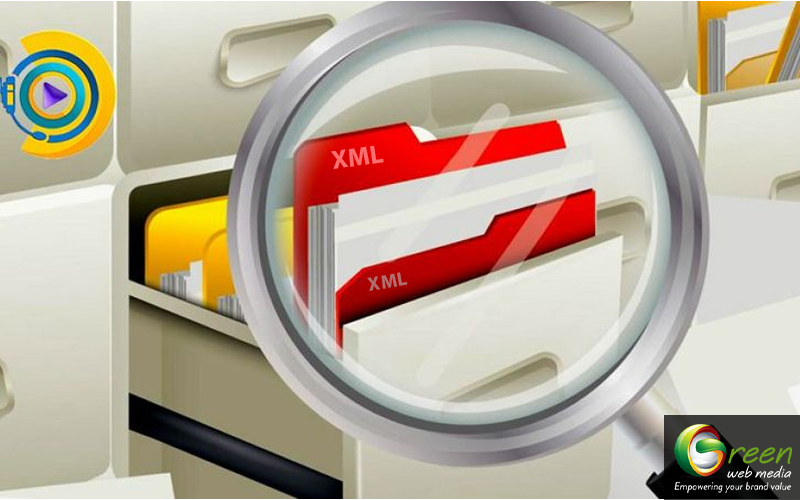What Is an XML File? A Beginner’s Guide to Extensible Markup Language

XML stands for Extensible Markup Language and is a simple way to store and exchange information using text. It lets you define and store data in a shareable manner.
But here is the thing- It isn’t just a data format. Rather, it is backbone of SERP visibility, controlling how Google ‘sees’ your site structure and content.
A well-optimized XML sitemap can mean the difference between pages languishing unindexed or ranking on page one.
In this guide, you will discover how XML works, why it matters, and how to create your own XML files. Ready to decode the hidden language shaping our digital world? Let’s explore this topic in greater detail.
What Is an XML File?
An XML file is a text file that utilises user-defined tags to define data. Unlike in some other formats, XML does not come with any fixed set of tags. You can rather create your own tags to work with. This makes XML highly flexible. You can use XML to hold a collection of books, a set of customer records, or even a document’s structure.
XML’s primary function is to hold and transfer data in a format that humans, as well as machines, can read. It serves as a bridge between various systems, such that it becomes simpler to exchange information-even if the systems have different technologies or data formats. You will frequently use XML files for web services, configuration files, and data exchange between businesses.

What are the Components of an XML File?
There are key elements in an XML file that help in making the data easy to read and well organized;
- Declaration
The optional header (<? xml version=”1. 0″ encoding=”UTF-8″?>) defines the XML version and character encoding.
- Root element
This is represented by a single parent tag (e. g., <catalog>). It encloses all other content within itself.
- Elements
These are user-defined tags (e. g., <title>). It can contain either textual content data or other child elements.
- Attributes
Additional metadata included in start tags (e. g., <book id=”101″>). They are used for describing elements and give more information about them.
- Content
This refers to the actual information that is included within the elements.
- Rules
There should be proper nesting, closed tags, as well as case sensitivity for the valid document
The components offer an adaptable format, which can be read by machines. They help in transmitting and saving information among different systems.

Why is an XML File Important for Your Website?
An XML file is often viewed as a site blueprint by search engines. It ensures efficient crawling, faster indexing, and optimal visibility for your website’s content. This aspect is especially critical for large, dynamic, or poorly interlinked sites. Let us look at the four key reasons why it’s indispensable:
1. Enhanced Crawlability
An XML sitemap acts as a roadmap for search engines. It guides them to all critical pages, so that no key pages are missed during indexing.
2. Faster Indexing
When you submit an XML sitemap via Google Search Console or Bing Webmaster Tools, it delivers a lot of value. You indicate the robots to crawl new or updated content, accelerating indexation.
3. SEO Optimization
XML sitemaps allow you to signal priority pages (via priority tags) and update frequency. As a result, search engines can allocate crawl budget efficiently. This is vital for SEO, ensuring high-value pages get crawled more often.
4. Error Identification
Lastly, a well-structured XML sitemap helps detect indexing issues (e.g., 404s, canonical errors) early. Regular audits of the sitemap ensure search engines only see valid, canonical URLs. SEO webmasters can prevent duplicate content penalties and maintaining crawl efficiency with its help.
XML Hierarchy & Syntax
An XML file has a simple but consistent structure. Every XML file includes elements, and each element is marked by a tag. All elements begin with a start tag and end with an end tag. The data is placed between these tags. All your tags should be closed and not overlap, so you must not leave any open or combine them.
For instance, this XML file includes a list of three movies-
<?xml version=”1.0″?>
<movies>
<movie>
<title>The Camel Run</title>
<genre>Comedy</genre>
</movie>
<movie>
<title>Gone with The Wind</title>
<genre>Drama</genre>
</movie>
<movie>
<title>ThunderBall</title>
<genre>Adventure</genre>
</movie>
</movies>
Let’s break down the key rules for writing XML–
- All elements need to be closed with a tag.
- The difference between <Title> and <title> is that tags are case-sensitive.
- Elements must be properly nested.
- Every XML file must have a single root element that contains all other elements.
- Attribute values must be quoted.
The first line, called the XML declaration, is optional but common. It tells the computer that this is an XML file and what version or character encoding it uses.
XML vs. HTML- What’s the Difference?
At first glance, XML and HTML look similar—both use tags like <this>. But here is the twist- they solve different problems. HTML focuses on displaying web content, using fixed tags like <p> for paragraphs or <img> for images. Crucially, some HTML tags work without closing pairs, like <br>.
XML, on the other hand, isn’t about visuals. Instead, it’s a toolkit for organising any data. Want a <product> or <weather_report> tag? XML lets you invent them. Just remember- it’s strict rules demand precision, unlike HTML’s flexibility. Think of it this way—HTML designs the websites, while XML quietly moves data behind the scenes.
In contrast, XML is used to store and move data, but not to show it. XML allows you to make any tags you need, provided you follow the proper syntax rules. XML requires you to be careful with upper and lower case, but HTML does not. In addition, XML is concerned with organising and interpreting your data. In comparison, HTML takes care of how your data is displayed.
For example, if you want to describe a book, you might use this in XML-
<book>
<title>Mandi’s Webpage</title>
<author>E. B. White</author>
</book>
In HTML, you would focus on how the information appears on the page, not on what it means.
Common Use Cases
XML is everywhere, even if you do not see it directly. Here are some of the most common ways XML is used-
1. Data Transfer
XML is perfect for moving data between different systems. For example, two companies might use XML to exchange order details, even if their software is different.
2. Web Services
Many web applications use XML to send and receive information. Technologies like SOAP and AJAX rely on XML for communication.
3. Configuration Files
Many apps use XML files to store settings. This makes it simple to modify how a software operates without altering its code.
4. Document Structure
XML can describe the structure of documents, such as books or articles. Formats like Office Open XML (used in Microsoft Word) are based on XML.
5. Industry Standards
Many industries have created their own XML-based standards for sharing information, from travel bookings to medical records.
Because XML is so flexible, you will find it in everything from e-commerce websites to scientific databases.
How to Create an XML File (Step Step)
It is not difficult to create an XML file. A text editor like Notepad is all you need. Take these easy steps-
- Open your text editor.
- Start with the XML declaration. It is optional. However, it is advisable to include this line-
<?xml version=”1.0″ encoding=”UTF-8″?>
- Add your root element. This is the main container for your data. For example-
<library>
- Add child elements. Each item or record goes inside the root element. For example-
<book>
<title>Matilda</title>
<author>Roald Dahl</author>
</book>
- Close your root element. Make sure every opening tag has a closing tag-
</library>
- Save the file with a .xml extension. For example, books.xml.
Remember to check your syntax. If you miss a closing tag or nest elements incorrectly, the file will not work.

How to Open & Edit XML Files
XML files are simple to open and edit as they are only text files. Any text editor will work. There are editors that include syntax highlighting, making it easier for you to read XML.
To see XML in a well-structured way, you can open it in Chrome or Firefox. You can simply open the XML file in your browser to see the data organised in a tree. Microsoft Excel can process XML files and present the data as a table.
You can modify an XML file using an editor, change the desired parts and then save your progress. Make sure your changes are in line with XML rules. It will help the file function correctly.

The Final Word
XML files are a powerhouse for storing and sharing data. But here’s the catch- their real strength lies in customisation. By letting you create your own tags—like <recipe> or <shipping_address> — they adapt to any data need, from shopping lists to scientific reports. What is more crucial, their strict rules keep information tidy. This ensures both humans and machines can read it effortlessly.
Unlike HTML, XML is not built to display data. Instead, it shines behind the scenes—moving details between apps, organising settings, or managing documents. This balance of simplicity and structure makes it a go-to for developers and businesses alike.






